|
Other Lansing Companies that contributed
to winning World War Two
Abrams
Instrument Corporation in World War Two
Recognizing a Company
from my Hometown that contributed to winning World War Two
Lansing, MI
1940-2012?
A Subsidiary of
Abrams Aerial Survey Corporation
This page updated 4-25-2023.
The Abrams Aerial Survey Corporation was founded in
Lansing, MI in 1923 by Talbert Abrams, who served as company
president 1923-1958. Mr. Abrams was born in Tekonsha, MI on August
17, 1895, and passed away in Lansing, MI on August 26, 1990. Mr.
Abrams became the "Father of Aerial Photography" in a city that is best
known for its manufacture of cars and trucks.
In 1977, I had the opportunity to be the
driver for Mr. Abrams during a parade in Lansing, MI. He was one
of several dignitaries riding in the backseats of Oldsmobile 98
convertibles provided by the Oldsmobile Division of General Motors as
guests of honor during
the parade down Michigan Avenue. I don't remember very much from
the hour or so that I was his driver. We probably made some small
talk during the time I was with him. At the time, I knew of his
company, but not much about it. However, it was not until I researched this web page
that I truly realized the accomplishments of Talbert Abrams as the
person who was in the backseat of that vehicle on that day. That
day was several lifetimes ago and I have gone through many different
phases and interests in my life. If I could go back in time and
relive that day, what questions I would have asked Mr. Abrams! How
was I to have known that 44 years later, I would be researching one of
the several companies he started and wish for more information than the
historical record provides?
Lansing is best known
as an automobile town. In 1923, when Talbert Abrams started the
Abrams Aerial Survey Corporation, Lansing had several companies making cars
and trucks. It also had many automobile suppliers such as stamping
houses, tool and die shops, engine manufacturers, a wheel manufacturer,
and several drop forges. For unknown reasons, Talbert Abrams chose
Lansing to start his Abrams Aerial Survey Corporation. Lansing was
lucky he picked it for the home of what at the time would be call "high
tech" today.

Talbert Abrams learned to fly in 1916.
His original pilot license was signed by Orville Wright. During
World War One he was a Marine Aviator whose assignment in the Caribbean
included taking aerial photographs of the islands in order to make maps.
After leaving the USMC, Mr. Abrams, like many other former World War One
pilots, purchased a surplus Curtiss JN-4. With this aircraft, he
was an airmail pilot for a short time and also used it to start taking
aerial photographs. Author's photo of replica JN-4.
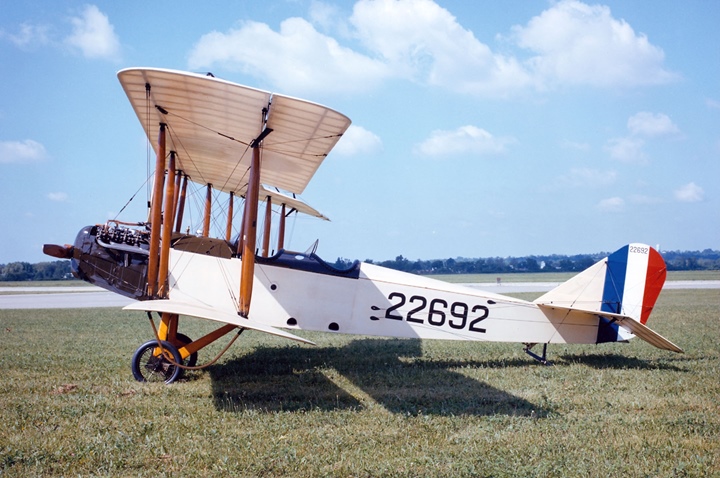
In 1922 Abrams purchased a Standard JS-1 and in 1923 he and his wife
Leota started the Abrams Aerial Survey Company. Over the next 50
years, Abrams Aerial Survey Company mapped 1,720 cities and 515 counties
in the United States. The company also did aerial mapping in 96
foreign countries. Standard JS-1 photo courtesy of the National
Museum of the United States Air Force Museum.
During World War Two Admiral Halsey informed
Talbert Abrams that the U.S. Navy extensively utilized Pacific survey
maps that his company had made prior to World War Two. This was a
significant contribution by the company to the winning of World War Two.
Today, satellite photos of the world are available to anyone through the
internet. But 80 years ago, as the U.S. Navy started its campaign
in the Central Pacific, little was known about the islands American
Naval forces were going to invade or attack. Talbert
Abrams' small company in Lansing, MI provided desperately needed mapping
information for the aircraft and ships of the U.S. Navy. The fact
that Admiral Halsey personally acknowledged this contribution shows the
status Talbert Abrams had achieved by World War Two.
Due to restrictions on civilian flying
during World War Two, contributions to the war effort were made through
Abrams Instrument Company, which was formed in 1940. During the
war years Talbert Abrams and his staff focused on building equipment to
aid the military in taking aerial reconnaissance photos and interpreting
them. During his long career, Talbert Abrams had multiple patents
and was the leader in aerial photography and its translation into map
making.
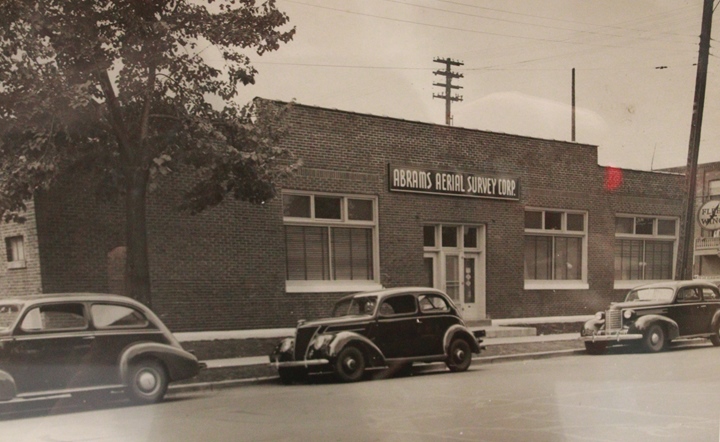
The Abrams Aerial Survey offices were
located at 606 East Shiawassee Street. This view is of the north
side of the building. Abrams Instrument was co-located at the same address.
This is not that large of a building for all of the maps and products
that were produced there. Sometimes size does not equate with
ability and inventiveness. Author's photo of
a of R.E. Olds Transportation Museum display photo.
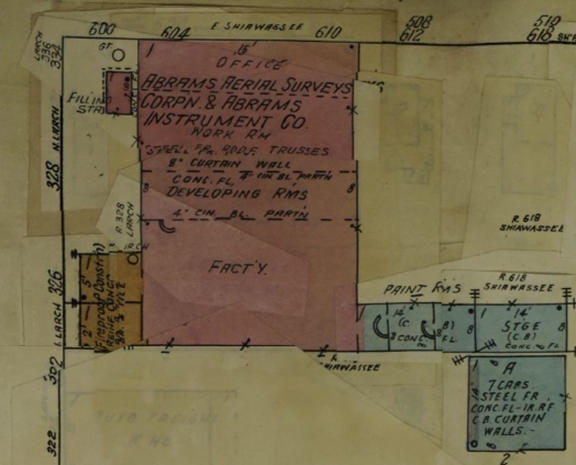
The Sanborn Map of Abrams shows its small
size.
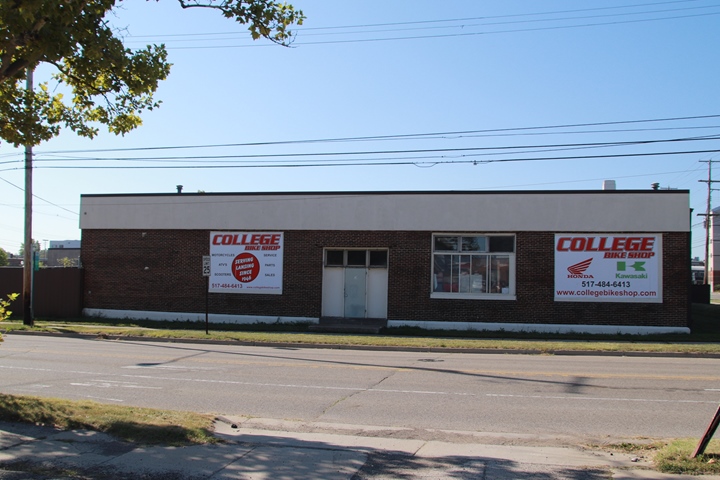
The building still exists. Assuming it
was built in 1923, it is in very good shape and still serves a useful
purpose. Author's photo.
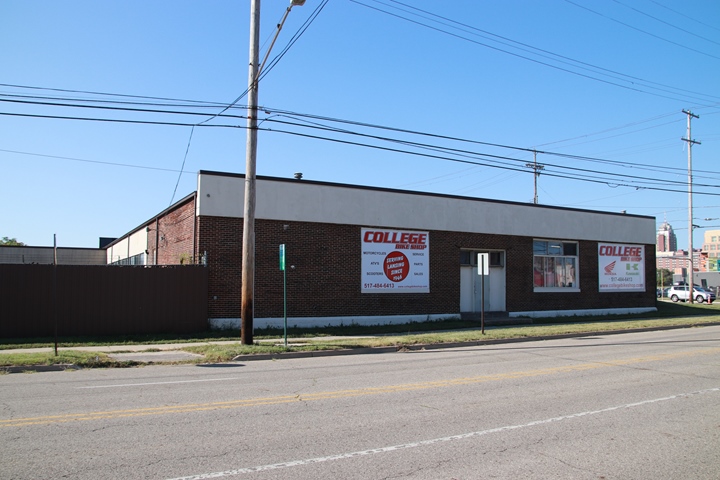
Author's photo.
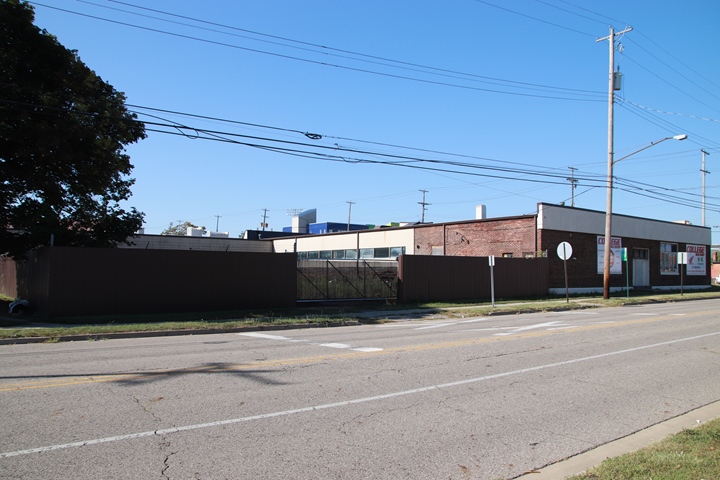
Today there is a fence along Shiawassee
Street, but the extension of the building on the east end is visible
above the fence. Author's photo.
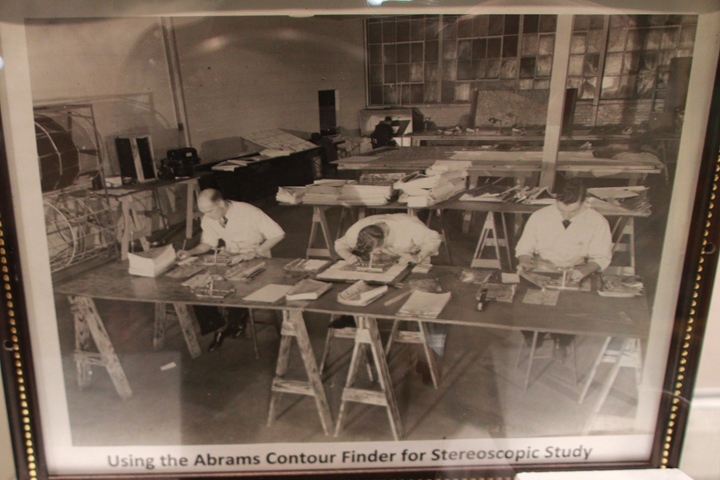
The use of sawhorses and wood sheeting for
operators' work benches is unique but cost effective. Author's
photo of an R.E. Olds Transportation Museum display photo.
Abrams Instrument Company World War Two Production: In
October 1940 Abrams Instrument received a $92,000 order from the U.S. Army Air Corps for printers for developing
aerial photographs in mobile dark-rooms.
26,000 Army CF-8 stereoscope map readers were
ordered at the end of 1942 with production beginning in January 1943.
This would appear to be the $82,000 contract awarded in November 1942.
Each unit cost $3.15. The U.S. Navy also appeared to order the
same product under a $58,000 contract in December 1942. Some
historical records indicate that Abrams also received a $128,000 contract
for the CF-8 in October 1940. However, there is no contract for
that type of instrument or amount in Table 1.
The company also produced aerial cameras, intervalometers, contact
printers, printer timers, camera mounts, height finders, contour
finders, assessing units, vertical and oblique sketch-masters, and
mechanical triangulation equipment for all three U.S. military services
during World War Two. It also engaged in subcontract work for
other companies as the need and opportunity arose. In 1943 Abrams
Instrument Company was testing out a new aircraft camera mount which
automatically adjusted for the pitch and roll of the aircraft while in flight.
Table 1 - Abrams Instrument
Company's Major World War Two Contracts
The information below
comes from the "Alphabetical Listing of Major War Supply
Contracts, June 1940 through September 1945." This was
published by the Civilian Production Administration, Industrial
Statistics Division. Table added 4-2-2022. |
|
Product - Customer |
Contract Amount |
Contract Awarded
|
Completion
Date |
| Assemblies
Printer - Army |
$92,000 |
11-1940 |
6-1941 |
| Finders Contour -
Army |
$64,000 |
8-1941 |
10-1941 |
| Printing
Assemblies - Army |
$225,000 |
9-1941 |
1-1942 |
| Equipment
Assessing - Navy |
$56,000 |
3-1942 |
7-1942 |
| Instruments -
Navy |
$147,000 |
6-1942 |
10-1942 |
| Photographic
Material - Navy |
$60,000 |
1-1942 |
1-1943 |
| Optical Equipment
- Army |
$82,000 |
11-1942 |
7-1943 |
| Optical Equipment
- Navy |
$58,000 |
12-1942 |
3-1943 |
| Triangulators -
Navy |
$61,000 |
2-1943 |
12-1943 |
| Cameras - Army |
$1,560,000 |
4-1943 |
2-1944 |
| Photographic
Equipment - Navy |
$148,000 |
6-1943 |
1-1944 |
| Plotting
Instruments - Army |
$56,000 |
5-1944 |
9-1944 |
| Sun Compasses -
Army |
$180,000 |
6-1944 |
8-1944 |
| Sun Compasses -
Army |
$57,000 |
9-1944 |
12-1944 |
| Sun Compasses -
Army |
$184,000 |
11-1944 |
4-1945 |
| Camera Controls -
Army |
$267,000 |
4-1945 |
10-1945 |
| Photographic
Timers - Army |
$490,000 |
6-1945 |
9-1945 |
| Total |
$3,387,000 |
|
|
Abrams Instrument Equipment on display at
the R.E. Olds Transportation Museum, Lansing, MI. The museum
is one of four that
I have found displaying artifacts from the Abrams Aerial Instrument
Corporation. Lansing is lucky to have a world-class
museum like the R.E. Olds Transportation Museum in its downtown area.
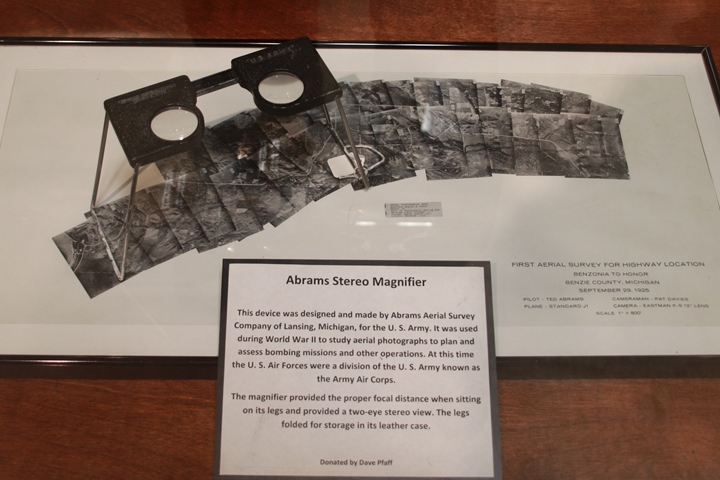
The Abrams Stereo Magnifier is covered by
patent 2,366,228A dated January 1, 1945, entitled "Optical Instrument."
Talbert Abrams, Milford Moore, and William Karr applied for the patent
on December 30, 1942. Author's photo.
The introduction to the patent reads: "This
invention relates to optical instruments, and more particularly to
stereoscopes. The principal object of the inventions is to provide
an optical instrument adapted to be opened into erect position when in
use and folded into a neat compact package when not in use.
Another object of the inventions is to provide a stereoscope in which
the inter-pupillary distance of the lenses can be easily varied.
A still further object of the invention is to provide a folding optical
instrument comprising a lens carrying frame and a pair of standards
there--for in which the frame is provided with means for automatically
latching the standards in erect position."
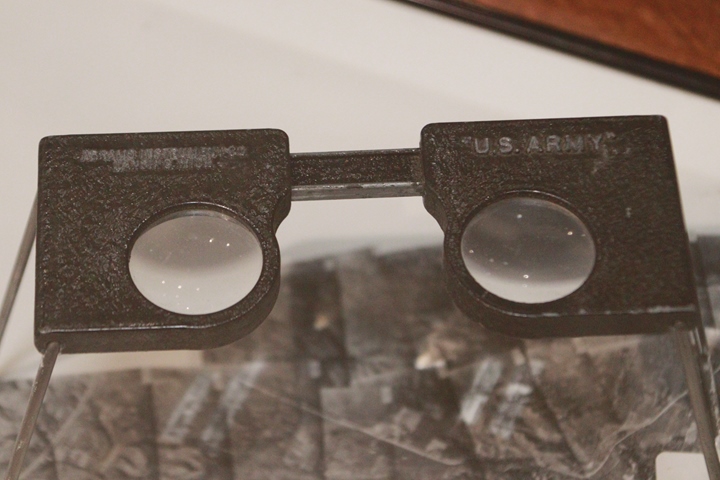
The
U.S. Army CF-8 stereoscope map reader on display at the R.E. Olds
Museum is a pre-1945 model.
Author's photo.
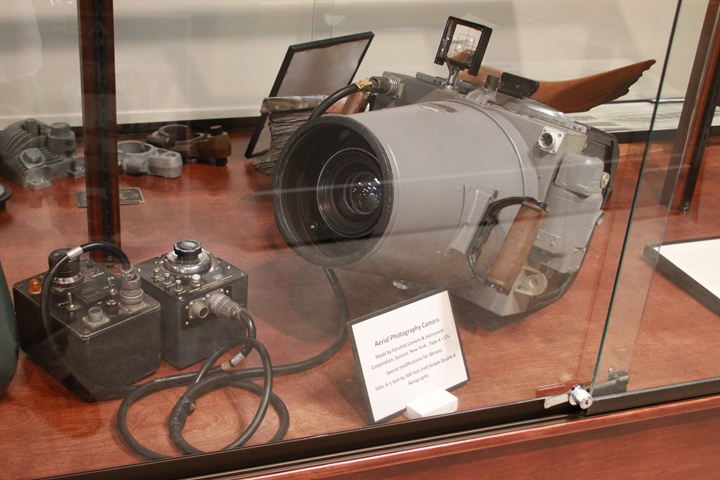
These two Abrams Instruments are connected
to an aerial camera. Author's photo.
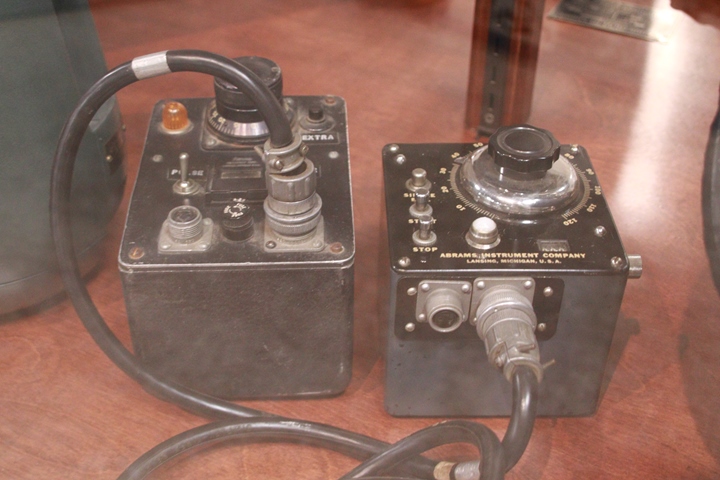
Author's photo.
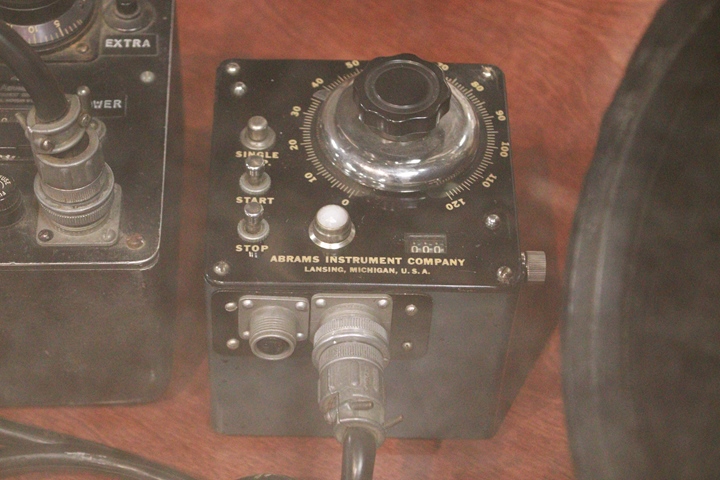
Author's photo.
Abrams Instrument Equipment on display at
the Liberty Aviation Museum, Port Clinton, OH: Between June
1944, and April 1945, Abrams had three contracts for sun compasses
totaling $421,000. This was 12% of the major contracts the company
was awarded during World War Two. All three contracts were ordered
by the Army Corps of Engineers.
Some sources indicate that the Corps of
Engineers used the SC-1 in the desert. While the desert campaign
in North Africa immediately comes to mind, the U.S. Army had moved on to
Italy and Europe during the course of the contracts for the Abrams sun
compasses. Whatever the location, the Army Corps of Engineers
wanted the sun compasses bad enough to reorder them twice.
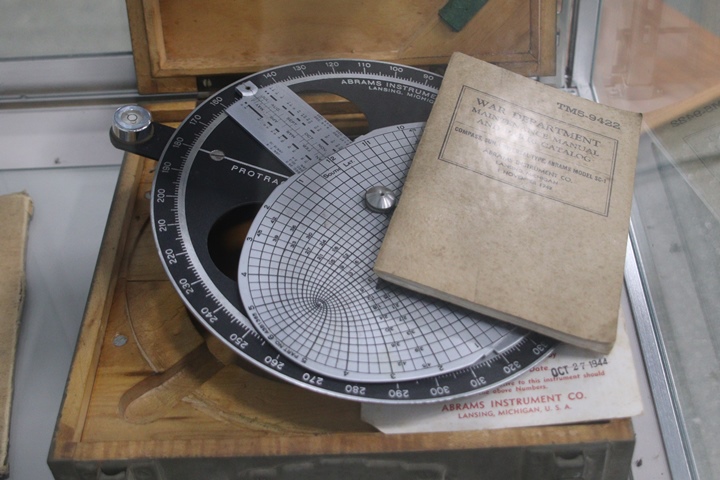
Author's photo added 4-25-2023.
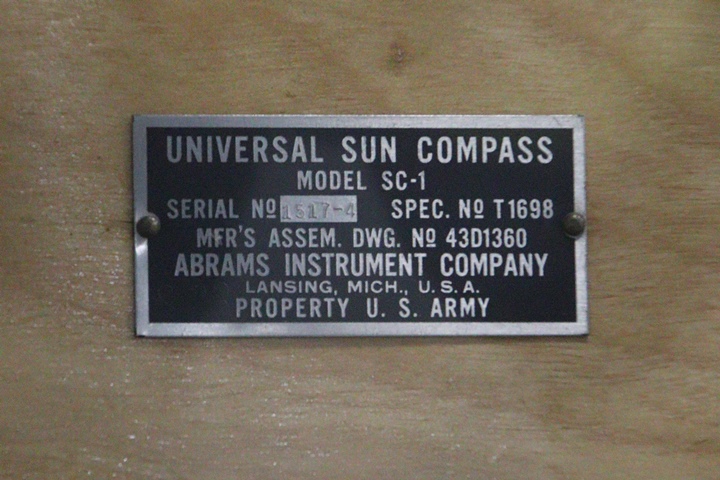
This is serial number 1517-4. I found
another unit in an online sale that was 3697-4. It is unknown how
many Model SC-1s Abrams made. Author's photo added 4-25-2023.
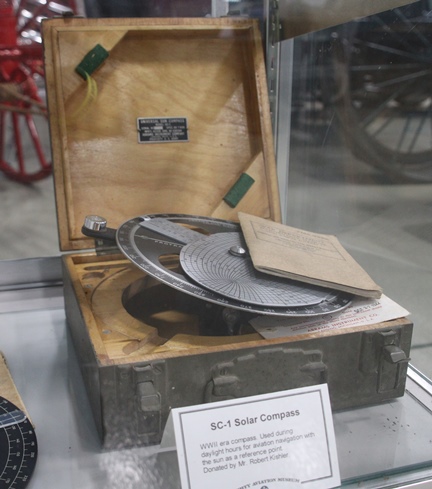
Author's photo added 4-25-2023.
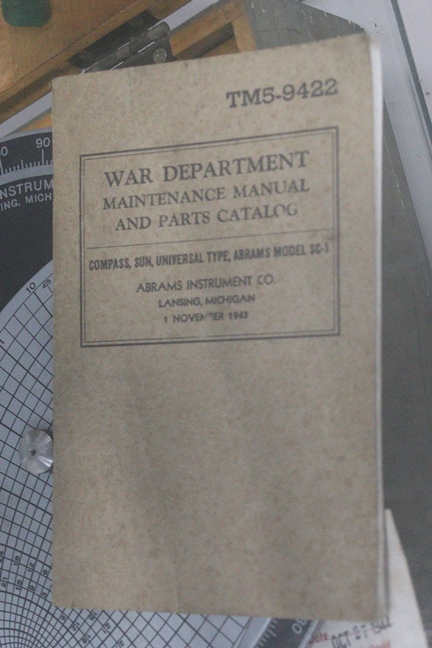
The manual is 28 pages long. Author's photo
added 4-25-2023.
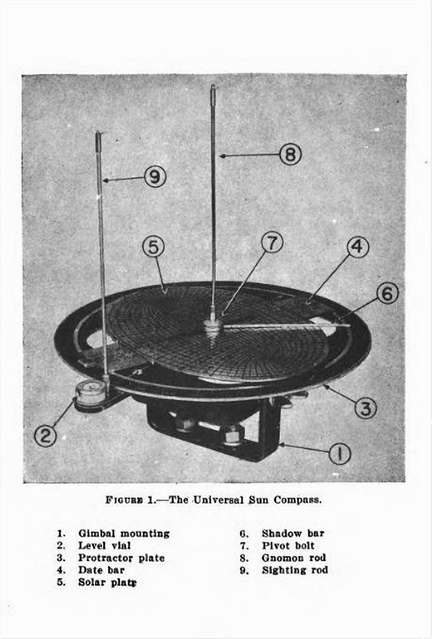
Here are several pages from the manual.
Image added 4-25-2023.
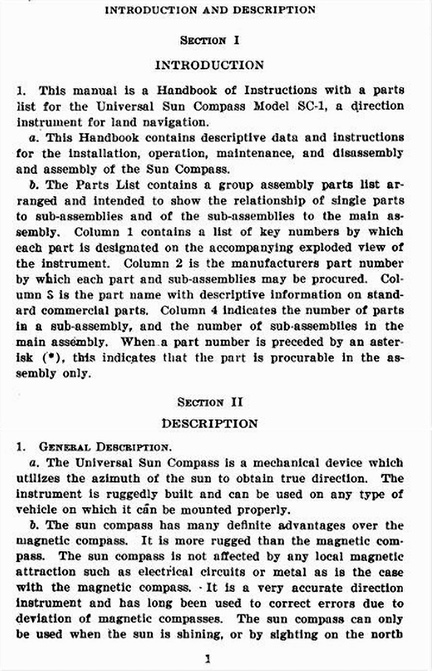
Image added 4-25-2023.
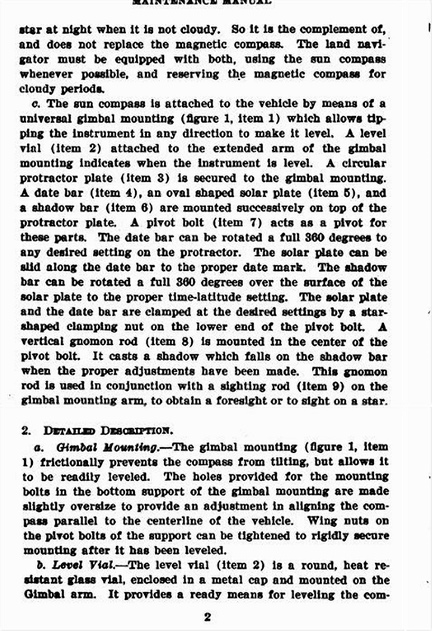
Image added 4-25-2023.
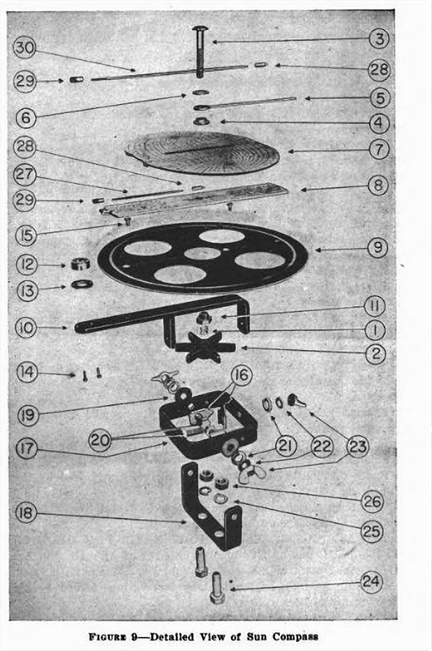
Image added 4-25-2023.
Abrams Instrument Equipment on display at
the National Museum of the United States Air Force, Riverside, OH: This is
the world's largest aviation museum and is the number one tourist
attraction in Ohio. Two pieces of Abrams-built equipment used by
the United States Army Air Forces in World War Two are on display at the museum.
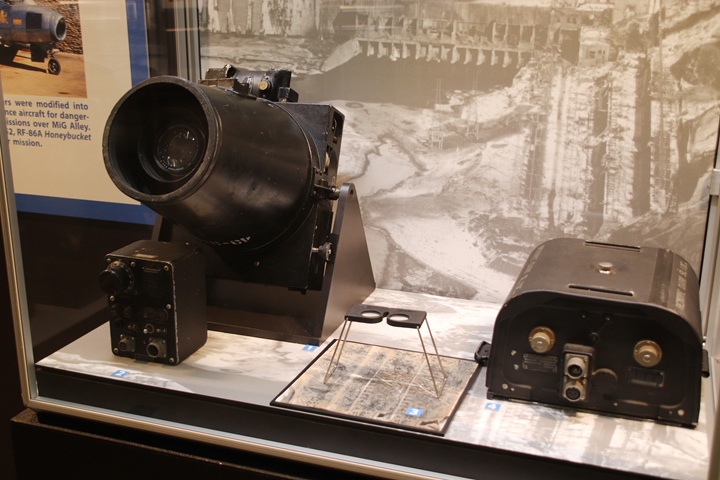
An Abrams-built CF-8 stereoscope map reader
is in the center of this display at the museum. The instrument in
the lower left hand corner is an Abrams Instrument-built intervalometer.
Author's photo.
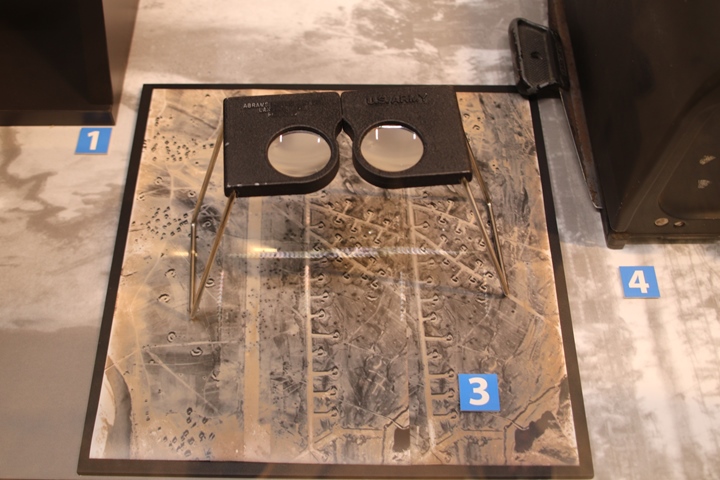
Author's photo.
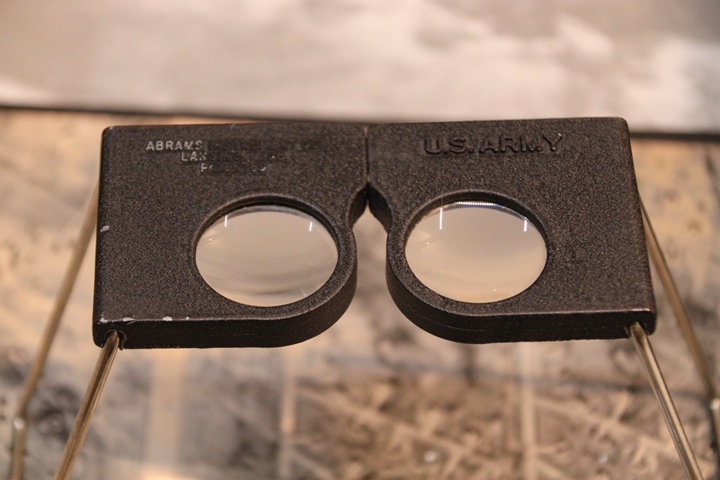
Author's photo.
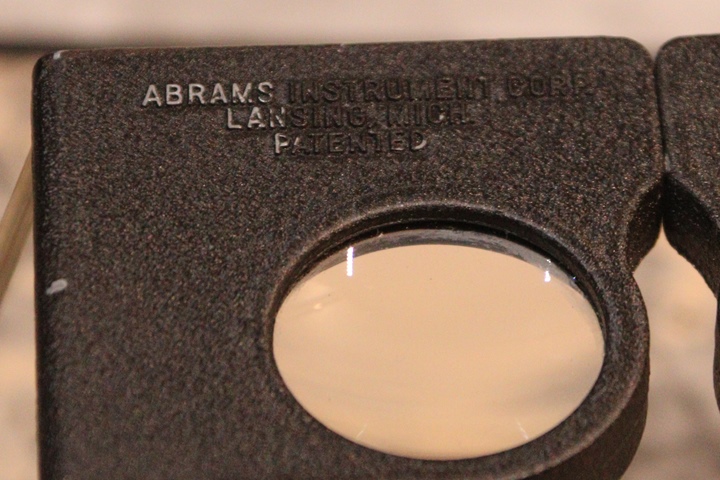
This photo shows that the lettering "PATENTED" is
on the frame, indicating this was built after January 2, 1945.
This also shows Abrams was still producing this product in 1945.
The one at the R.E. Olds Transportation Museum does not have the
"PATENTED"
lettering, indicating it was built earlier in the war. Author's
photo.
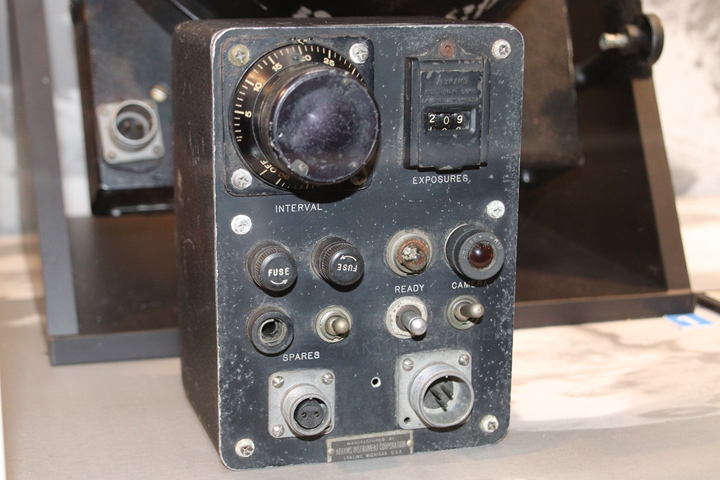
The intervalometer has Abrams Instrument
Company marked on it in two places. One is the data plate at the
bottom of the instrument and the other is above the number "209" in the
Exposures window. The serial number for this unit is 1100,
indicating the company built at least this many intervalometers.
Author's photo.
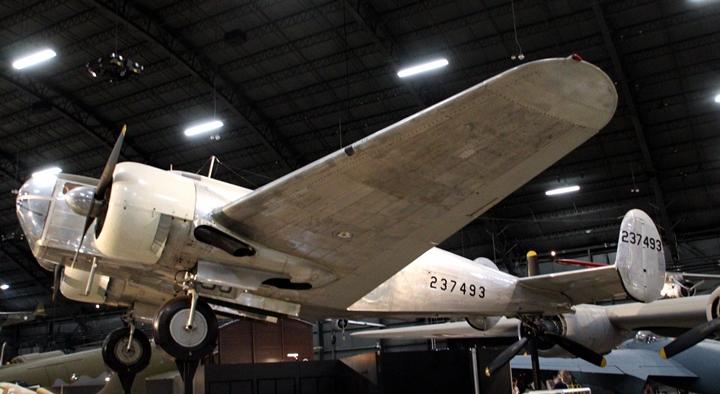
How cool is this? Not only does the National Museum of the United
States Air Force have two Abrams products on display, but it also has
this AT-11 on display that was donated by the Abrams Aerial Survey
Corporation of Lansing, MI in 1969. It is one of 1,584 that were
built during World War Two. Author's photo.
Abrams Instrument Equipment on display at
the Cradle of Aviation Museum, Long Island, NY: On display at
the Cradle of Aviation Museum is an Abrams Instrument Company 1945
Torpedo Camera Assessor for use on U.S. Navy TBM torpedo bombers.
This instrument shows a unique instrument the company built for the U.S.
Navy.
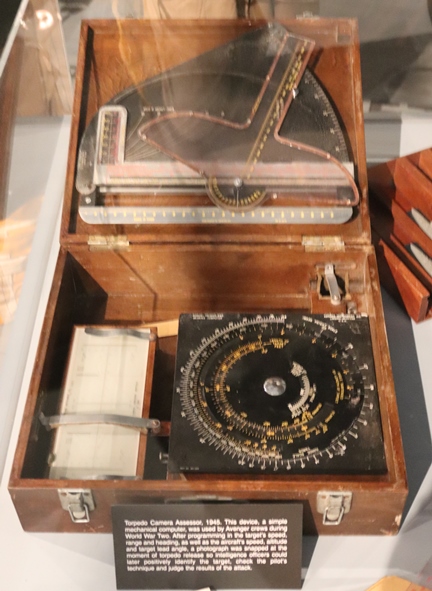
Author's photo added 1-13-2021.
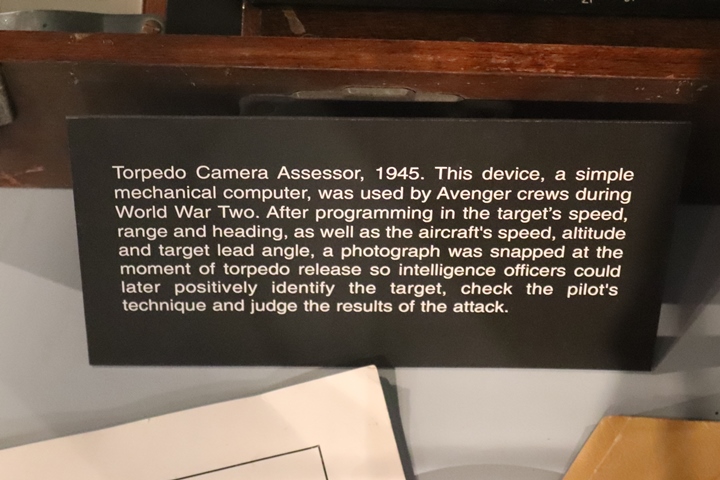
Author's photo added 1-13-2021.
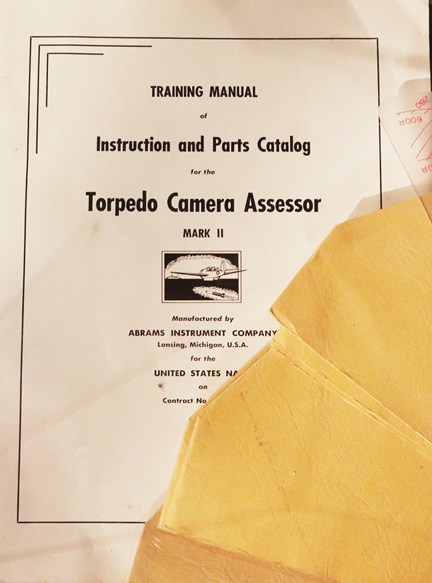
Author's photo added 1-13-2021.
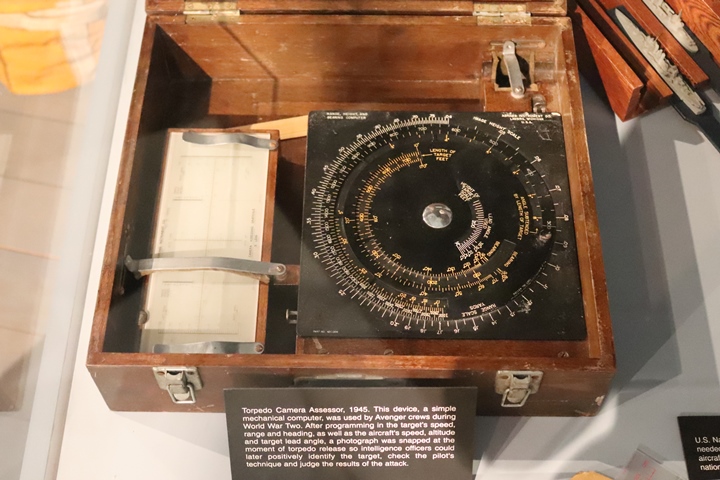
Author's photo added 1-13-2021.
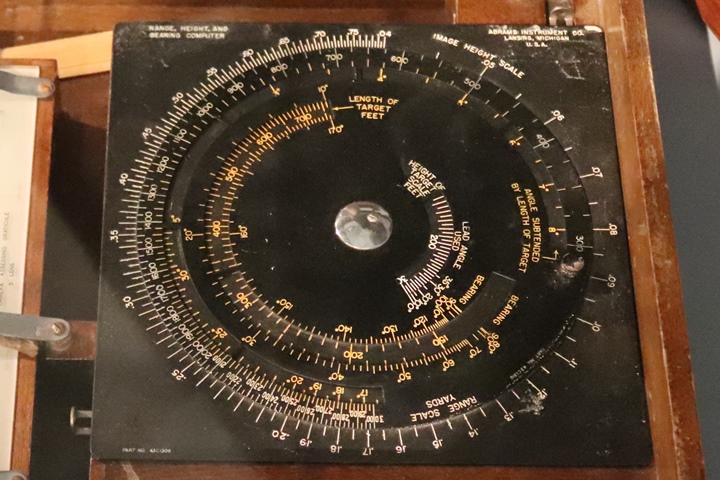
This photo shows the Abrams Instrument
Company name in the upper right-hand corner of the dial plate.
There is no indication that this is an Abrams patented device. The
historical record shows that at least one other company built the
Torpedo Camera Assessor during World War Two. Abrams may have been
building this unit under license from another company. Author's
photo added 1-13-2021.
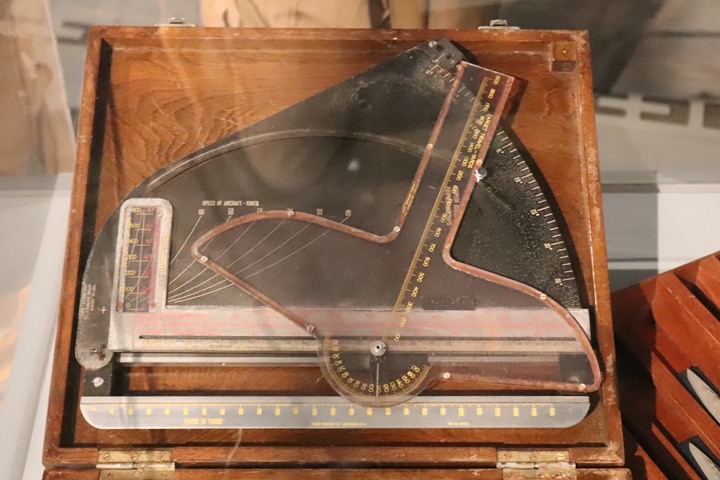
Author's photo added 1-13-2021.
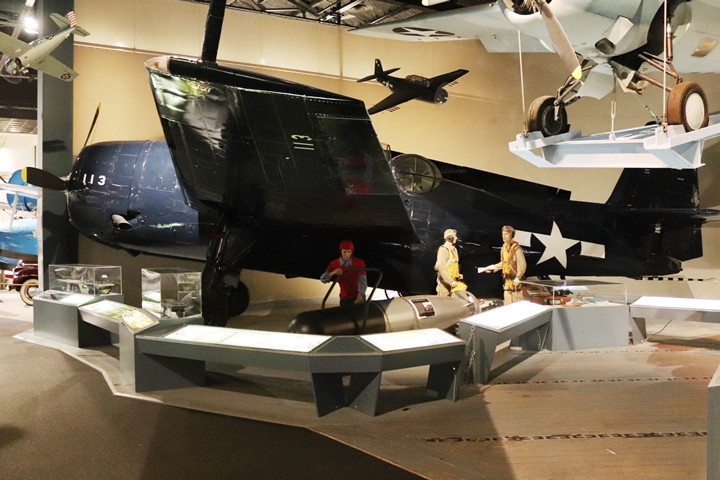
The TBM torpedo bomber was the largest U.S.
Navy carrier borne aircraft of World War Two, as indicated by the size
mannequins in this display at the Cradle of Aviation Museum.
Grumman built 2,293 of the original TBFs and the Eastern Aircraft
Division of General Motors built 7,546 license-built TBMs.
Author's photo added 1-13-2021.
Abrams Instrument Company after World War
Two:
-
1961 - Abrams
Instrument was sold to the Curtiss-Wright Corporation. All of the
current employees were retained with the exception of Talbert
Abrams, president of the company, who retired.
-
1964 -
Curtiss-Wright sold Abrams Instrument to J.A. Maurer, Incorporated.
This was a better fit for Abrams, as J.A. Maurer specialized in
aerial cameras and equipment. Curtiss-Wright was an aircraft
and engine manufacturer, which was having extreme difficulty staying
competitive in the post-World War Two aviation market.
-
1969 or 1970
- Abrams Instrument Corporation was sold to Royal Business Funds
Corporation. J.A. Maurer was still the owner in February 1969.
-
1971 -
Abrams Instrument Corporation was purchased by its employees from
Royal Business Funds Corporation.
-
2000-2012 -
Abrams Instrument Corporation received $3,242,792 in defense
contracts. The last contract in 2012 was for $26,222 which was
less than 10% of the contracts in previous years. It appears
that 2012 was the last year the company did any business. The
address associated with these military contracts was 1322 Rensen
Street, Ste A, Lansing, MI 48010.
-
2013-Present
- Starting in 2013, there were no more defense contracts.
Google Maps street view shows a sign in front of the building with
Abrams Instrument as tenant at 1322 Rensen Street. However, in
the view, there is a dumpster in front of the building. The date of the Google Maps
street view is unknown.
-
January 2023 - I
was in Lansing in January and drove by 1322 Rensen Street. The
building no longer has any evidence of Abrams Instrument at this
location. It was being utilized as a garage or automotive repair
facility. There was no identification of who currently
occupied the building.
World War Two introduced
Abrams Instrument to the world of defense contracting which continued
through 2012. With the advent of the space race in the 1960s, it
became a supplier of instruments for NASA.
Known Post-World War Two
Military Products: Bombing timers for the F-4 and F-111, ammunition counters for the AH-1 Cobra attack helicopter,
and various
fire control equipment for other aircraft of the Vietnam War era.
Known Products for NASA:
Guidance Systems for Surveyor, Lunar Orbiter, and Apollo. Navigation
display units for Lunar Rovers. Six Abrams motors for the X-ray
camera on Skylab were used to photograph the sun.
Afterword:
The American Surveyor: Talbert Abrams - The Father of Aerial
Photogrammetry:
I have
only been able to tell a small part of Talbert Abrams' story and his
accomplishments.
This article in the American Surveyor Magazine
is an excellent article on Talbert Abrams and his life of
accomplishments.
Other Lansing Companies that contributed
to winning World War Two
|

































